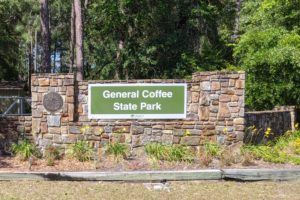We’re on our way to Truckee to see our youngest son, Matt, and his family and celebrate Tucker’s birthday (11), his graduation from grade school, and Montana’s graduation from middle school. Such exciting times for this family. But first we decided to spend a few days in Carson Valley, Nevada, just inside of California on US-395.

While at home in Georgia, we normally go out for breakfast on Fridays, and I’ve been missing out on these outings for something different for breakfast. We stayed at a campground on Topaz Lake at a casino. Since we arrived just after noon, we took our casino coupons into the dining room for a late lunch. This was our view.

We really don’t know anything about this part of the state, so we started out at the visitors center and started learning. First, the name of the valley and the name Carson City is from Kit Carson’s influence in the area. More about him as we travel along. We’re going to be spending time in Gardnerville, Minden, and Genoa.
history of Carson Valley

We’ve all heard about the 1849 gold rush in California, but we didn’t know much about the trail the pioneers took to get there (except for what happened at Donner Pass if we remember California history). We’ll add to this story when we get to the museum at the Mormon Station in Genoa, but here’s how it started from what we’ve been learning.
All of the wagon trains started out at the same place, Independence, Missouri, and followed The Oregon Trail. At Salt Lake City, some pioneers split off for Portland, while the pioneers we’re following took off for the gold fields of California on The Central Overland Trail through Nevada.

When the emigrants arrived at the end of the Humboldt River where it just disappears, they have 40 more miles of desert without water and little game. This stretch of 40 miles saw more death of humans, oxen, and other livestock that anywhere else on the entire trail.

I’m not positive what this additional 26-mile desert is, but I think it’s the distance from the end of the Humboldt River called the Humboldt sink through the Carson Sink, which becomes the Carson River. When we googled 26-mile desert, the reference is for State Historical Marker 26 for the 40-mile desert. Do you have any more information about this? Let us know!

Carson Valley became a lifeline to the emigrants before they took the route to California over the Sierra Nevada mountains.

This trail is called the Emigrant Trail and is also the Pony Express Trail.
Just south of Mormon Station (future Genoa), the emigrants (and riders) took the Daggett Pass (now SR-207). How they found this pass is an interesting story that we’ll talk about that later.

We decided to drive the pass and got to see our first look for this trip of South Lake Tahoe. What a view this must have been for the travelers. You can see a hint of the lake in the previous picture’s right-hand corner.

As we drove into and out of town, we saw this stature of a pony express rider.

Back to history. Ranching around Genoa became the industry in Carson Valley by selling food stuffs and livestock to the gold seekers.
- 1851 – crop of turnips planted and sold in the fall for high prices
- 1852 – first 260 acres were under irrigation; traders and station keepers started changing the west fork of the Carson River to help with irrigation, which was the start of ranches, dams, ditches, and fences
- 1857 – first 96 acres of East Fork of Carson River under irrigation
- 1859 – Comstock Lode discovery just a little north brought amazing agriculture prosperity to Carson Valley. It was the area’s bread basket for the next 20 years

Comstock Lode discovered in 1859 brought miners from California to search for the gold and silver. Towns of Virginia City, Gold Hill, and Silver City were part of the mining district and soon boomed as mining towns.

Mining in Nevada required the timber from the Lake Tahoe area for the mines themselves as well as for the mining mills, stores, hotels, boarding houses, homes, and wood for cooking and heating. Sounds like Bodie.



Up to this point, Nevada was part of the Utah Territory governed by Mormons in Salt Lake City. In 1861, Nevada Territory separated and adopted the name Nevada. Its name had been shortened from Sierra Nevada, Spanish for “snowy range.” Don’t know if this separation was a friendly one.


back to early wagon trails
Traveling to California started in the early 1840s but took off in 1849 with the discovery of gold on January 24, 1848, at John Sutter’s sawmill on the South Fork of the American River, about 40 miles east of Sutter’s Fort. While wagon trains had been small before this time, the lure of gold created a gold fever epidemic. Thousands of travelers added new trails to California, and trails became roads.

In narrow places, the wagons would travel one behind another, but where the landscape permitted, they spread out, along with their cattle and other livestock.
Staying healthy on the trail was important. Here are some of the pioneer medicines that they used. Find a cure for you?

Here are some home remedies that the pioneers used on the trail.


end of wagon trains
Completion of the transcontinental railroad in 1869 connecting the Union Pacific from the east and the Central Pacific from the west hailed a new and exciting way to travel from coast to coast in days instead of months, but also signaled the end of the wagon trails.
more Carson Valley history







